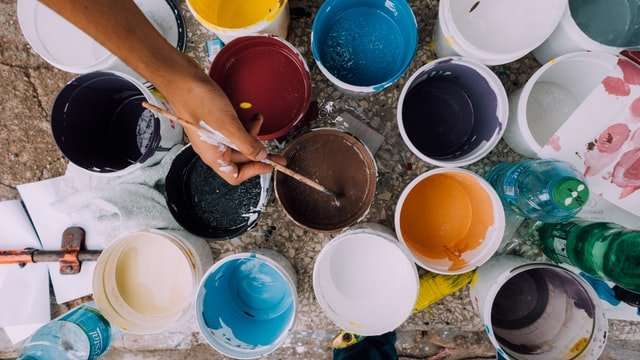“A History of Modern Art” is a series of posts I made on the now defunct blog “nft digital art”. It explores the abstract, minimal, pop art and conceptual art movements as well as the postmodern era.
These are the most important styles and movements in modern art that have inspired some of the biggest names in contemporary art today. I hope you enjoy reading them as much as I have enjoyed writing them.
All images and quotes in this series were taken from Wikipedia and are available under Creative Commons licenses which allow for reuse with proper attribution. All text is original unless otherwise stated.”
Digital Art: The 21st century has brought with it a new way of creating art, a computer. Digital art is an extremely popular form of art as it is not only easy to create but also gives the artist the opportunity to experiment with different styles, selecting whichever one they prefer. It is an exciting time for digital artists as they are constantly developing their ideas and experimenting with new styles. This article will provide a history of modern art and how it influences digital artists today.
History: Modern art originated during World War I when many artists began to break away from the traditional forms of painting in an attempt to find new ways to convey their feelings to people. The style was heavily influenced by Cubism which was a revolutionary style at the time. As the years went on, more and more artists began to experiment with abstract and surreal forms of art as this movement became increasingly popular in the 1960s.
Artists like Andy Warhol began producing unique works that were created using techniques such as silk screening, film making, painting and sculpture. These methods were used by many other modern artists in order to create their own original works of art. Many artists use technology such as computer software in order to manipulate images and enhance their work further. In fact, many digital artists have begun incorporating
“The term ‘Modern Art’ was first used in the 19th century, but most people agree that it only really took off in the early 20th century. The earliest Modern Artists wanted to express a new way of seeing that they felt had been opened up by technology.
Artists such as Wassily Kandinsky and Kazimir Malevich were interested in abstraction and other ways of representing what they saw in their own minds. The cubist artists, like Pablo Picasso and Georges Braque, wanted to represent their subjects as three-dimensional objects using a radical new approach to perspective.
It is impossible to talk about modern art without talking about the artists of the era who have become synonymous with it. Artists like Marcel Duchamp, Salvador Dali, Andy Warhol and Jackson Pollock are all hugely influential figures whose work has had a huge impact on how we think about art.”
In the 19th century, the definition of art became more and more complex. The definition of art was being debated and redefined all throughout the 20th century. Also, Modern Art has had a huge influence on the way we perceive abstract art today. This essay will explain how and why Abstract art developed during this time period, as well as provide a brief history of Modern Art.
Towards the end of the 19th century, artists began to question what exactly defines art. They began to ask questions such as: What is it that makes one object a work of art and another not? Is it necessary for an object to have a function in order for it to be classified as art? Can objects created by machines be classified as art?
The idea that an object should have a utilitarian purpose started disappearing. As society became increasingly industrialized, people began to associate labor-saving devices with progress. In fact, according to Thomas Bender, in his article “The Intelligentsia” (in A History Of Private Life II) “the aesthetic came to be seen by many intellectuals as itself a machine.” A person no longer needed to be able to create something with their hands; a machine could do it for them. The rise of technology resulted in new forms of
In the decades surrounding the turn of the last century, a revolution in art was taking place. Artists across Europe and America began experimenting with new media and styles that would soon revolutionize the world of art. The advent of Modernism is one of the most important moments in art history, and it remains a hotly debated topic to this day.
Treated as a period style starting around 1910 with the works of Picasso, Matisse, and others and lasting until about 1945 with Abstract Expressionism, it was during these forty years that art was transformed on the level of both form and content. The innovations helped to lay the foundation for all modern art, from Pop Art to Minimalism to Conceptual Art.
The last quarter of the 19th century can be seen as one of general transition from Romanticism to Realism. As artists became more aware of their individual visions they began to look back at historical styles less, searching instead for more contemporary ways of expression and new forms in which to explore them. While Impressionism has often been credited with bringing about such changes, it is only one style among many that led up to Modernism.
The Post-Impressionists were also interested in breaking away from traditional painting techniques, though their interests were more focused on
The first major break in art history was the Post-Impressionist period. In general, this period was marked by the rejection of traditional values, as well as realistic and naturalistic painting styles.
Post-Impressionism began with Paul Gauguin and Georges Seurat, but its most famous figure is Vincent Van Gogh. Van Gogh’s most famous painting is “The Starry Night,” which depicts a village under an ominous sky. The painting is quite simple when compared to other works of art from that time, both in subject and style.
The next period in modern art history is Fauvism, which began around 1905 when Henri Matisse and Andre Derain exhibited together at the Salon des Independants in Paris. The name “Fauvism” comes from the French word for “wild beasts,” a term used by critics to describe the patchy, loud colors used by the artists during this time. Most paintings from this time are very colorful and abstract; they also lack any sort of realistic form or structure, instead focusing on lines and shapes.
Since the mid-19th century, the art world has been dominated by large, international exhibitions. The most influential of these were the 8th, 9th and 10th editions of the International Exhibition of Modern Art (the so-called “Biennials” or “International Exhibitions of Modern Art”), which took place in Venice from 1895 to 1914.
The first Biennale, known as L’Esposizione Internazionale di Belle Arti di Venezia, was held in 1895 under the aegis of Napoleon III, Emperor of France and King of Italy. The second Biennale was held in 1897 and titled II Esposizione Internazionale di Belle Arti di Venezia: Le Arti Decorative. The third Biennale was held in 1899?1901. Its works are catalogued in Guglielmo Piombini’s catalog (1904).
In 1902, at the fourth Biennale, an ‘Historical Exhibition’ was instituted; it presented works from many periods and nations. From 1903 until 1914 the name changed repeatedly: Esposizione Internazionale d’Arte di Venezia is used for five years; it changes to Esposiz


